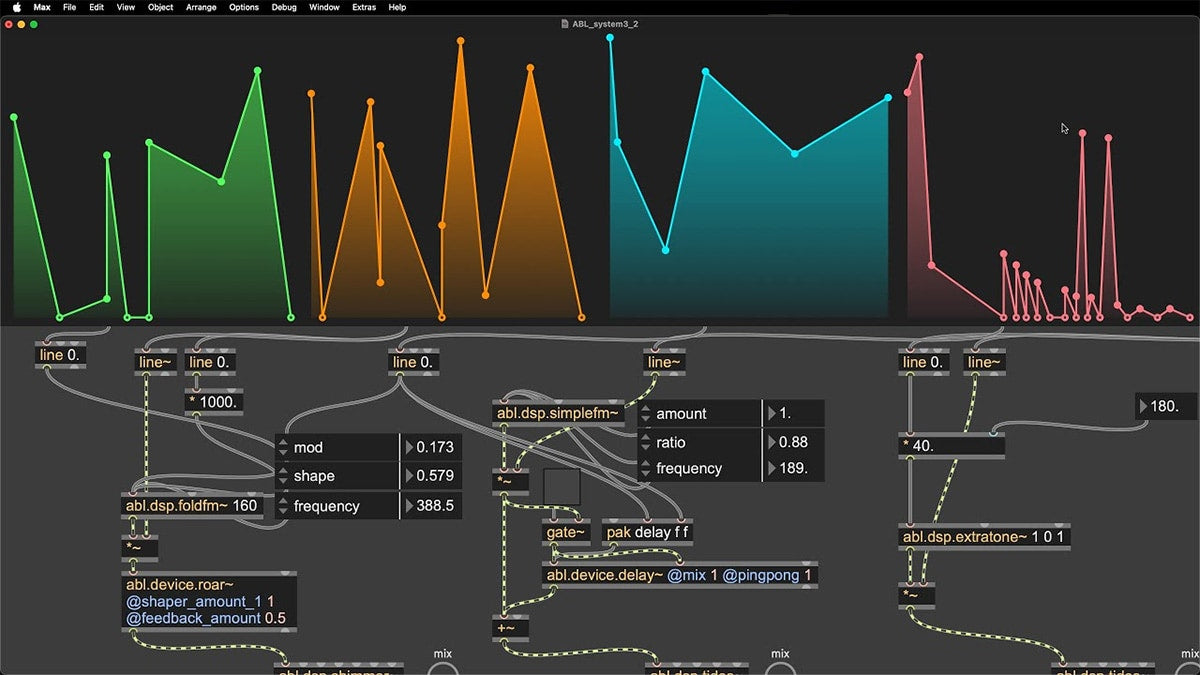Cycling '74 Max 9
Standalone Patching Environment Software
A Playground for Invention
Max is an infinitely flexible space to create your own interactive software.
Each object does something. Max has objects that generate sound waves, represent hardware, or provide a UI for interaction.
Patchcords connect one object to another. This connection lets objects share their output with connected objects.
Connect UI objects like dials and sliders to provide control values or display results. Modulate, map and scale data to get just the right results.
Max 9 is more direct, more transparent, and full of inspiring new features that will spark your curiosity.
Version 9 brings a new collection of audio objects based on Ableton's ABL library, the biggest Jitter update in years, interface improvements, reinvented coding workflows - and much more.
The ABL Objects
We're excited to offer a suite of Max objects created with Ableton's ABL library for DSP.
These objects offer a patchable interface to the internal workings of some of Ableton Live Suite's most popular devices.
Whether you're looking to explore some wild distortion effects (abl.device.roar~) or dreamy reverbs (abl.dsp.shimmer~), the ABL library has got you covered.
Patching with Code
Patching in Max is even more powerful when you integrate text-based code.
Max 9 presents a new vision of code integration with patching - including a fully reinvented, fast and modern Javascript V8 engine.
Even if you've never tried integrating Javascript and Max, you'll definitely want to check out what is possible.
Codebox Everywhere
Stay in the flow with codebox, which enables direct text-based coding alongside visual patching.
Codebox variants provide support for JS (v8), Gen (gen, gen~, jit.gl.pix, jit.gen), and Node for Max, as well as dictionary and coll editing and OSC display.
New V8 Objects for JS
To access the new performance and compatibility features of Javascript V8 in Max, we've introduced the v8, v8ui, and v8.codebox objects.
With these new objects, you can make use of more modern (ES6+) language features like arrow functions and typed arrays, and in many cases enjoy a big speed improvement over the standard js object.
Introducing Jitter Geometry
In Max 9, we're going beyond the Jitter Matrix with a new way to represent 3D geometry data and several new realtime geometry objects to manipulate and fine-tune your 3D graphics in Jitter.
Enhanced Visuals with Jitter FX
The new jit.fx library of image effect objects makes creating interactive visual effects in Jitter more streamlined than ever.
Enjoy a full range of realtime, shader-based processes with an easy-to-use Max interface.
Included Effects:
- Color adjustments and corrections
- Stylized image manipulations
- Distortions and Blurs
- Blending and Compositing
- Time delay and temporal displacement
New in Jitter
In addition to the exciting new jit.geom objects and jit.fx, Max 9 brings exciting new additions that enrich Jitter in both practical and inspiring ways.
In-Window UI Objects
Use jit.ui objects to build kiosk experiences or interact with your patch without leaving fullscreen mode.
3D Widgets
Directly edit your 3D scenes in Jitter with updated, in-window UI widgets.
Scene Rendering
Max 9 introduces ReSTIR-based global illumination, order-independent transparency, depth-sorting, and new scene FX passes to add texture and grain.
Jitter in Production
Switch Jitter into post-production and animation mode with new "fixed_delta" attribute for jit.world, jit.mo, and all animation-driven objects in Jitter.
New objects jit.bang and jit.frame also help in syncronizing your processes with rendering.
Remote Control
Parameter Connect
Easily connect UI objects in Max to supported object attributes without any patchcords.
This feature is currently supported by all ABL, jit.fx, and Gen objects, as well as jit.gl.slab.
Javascript V8 object support can be enabled by using the new JS attribute API.
OSC Integration
A new global preference allows you to set application-wide OSC address and port settings, and all parameter-enabled objects in your patch are automatically available to OSC messages.
The param.osc and osc.codebox objects let you inspect OSC state and communications.
Improving Your Patching Life
Thoughtful improvements to the Max environment that will enhance the way you patch, play, and explore.
List View
Explore the objects in your patch with a list-based interface.
Rapidly filter, search, and edit objects, and watch the numbers change.
Syntax Coloring
Inspired by our favorite code editors, Max syntax coloring makes it much more comfortable to read Max patches.
Global Record Button
Max moments are often fleeting, but now you can capture any audio from Max, in the moment, with the new Global Record Button in the Max Toolbar.
Preset Mixing
Connect a nodes object to preset to easily create an interface that lets you mix and interpolate presets across a 2D space.
Command Your Patcher with REPL
The familiar Max Window has a new input field that turns it into a command-line interface to your patch.
This input allows you to send text messages to named objects in your patch, send messages to the application itself, execute Javascript, or query the documentation.
System Requirements
- MacOS 11 Big Sur and above
- Windows 10 and above (64-bit only)
- Intel, AMD, or Apple Silicon CPU
- 4GB RAM or more (8GB or more recommended)




